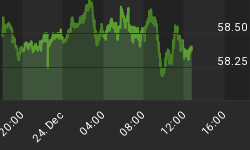We examine three scenarios
In late January, we mentioned that we were watching gold to see whether price could break through overhead resistance represented by a channel line and also the specific Fibonacci-derived level of 1730.50. Breaking through would have favored a near-term bullish view. However, since that time, price has fallen away from the channel line and is on the verge of making a fresh low on a weekly timeframe. This makes one of the near-term bullish counts less likely, although it cannot yet be ruled out. Of the other two prominent counts, one is near-term bullish, and the other would call for more choppy action before price can really attempt to rise much.
Prudent traders would have lightened any long positions as price approached the upper channel line shown in the previous article, and they would have waited for a breakthrough as confirmation of the immediately bullish view - confirmation that did not come. From here, with price now testing lower, it helps to step back a little bit and get a larger perspective.
Three prominent Elliott wave counts are shown in the weekly candle chart. Of those, two counts are near-term bullish. The third count is net bearish over the next year or so, but it also calls for price to climb in the longer view. Below, we describe some of the events to watch in favor of each scenario.

Scenario 1
The first near-term count, shown in green, suggests that the corrective move ended in early 2012, and that price has been trying to make its way higher in wave '(v)' since then. This count is on its last legs. In order for it to work, price would have to bounce from a level higher than the area labeled as 'y' of '(iv)'. Already, the recent down-move looks as though it is probably too large to be a retrace. This scenario should be dropped from consideration if price breaks below 1546.20.
If the green-labeled count is ruled out, and price has not yet begun an impulsive move upward, then it must still be tracing its way through the corrective move that began in 2011. The two scenarios under this possibility are indicated with the blue labels. Of those scenarios, one is near-term bullish (similar to the green-labeled count), and one calls for price to test new lows before it can resume its journey upward.
Scenario 2
The second near-term bullish count, which is one of the counts shown in blue, has practically the same implications as the first (green) count, and yet this one cannot be ruled out. In this scenario, price may be just on the verge of completing two years of correction, now finishing the downward move '(c)'. If this were the case, then price would soon start on its upward path to retest and possibly exceed the 2011 high.
A factor favoring scenario 2 is that the 45-week cycle, shown at the bottom of the chart, is currently near a trough. This adds to the possibility that some kind of bounce may occur around March or April of this year, but it does not necessarily mean that the bounce will be a strong or lengthy one. A small bounce could play out to manifest the third scenario.
Scenario 3
Probably the most likely scenario is that the long corrective move has several more months of action yet to go. The current low on the weekly chart may represent just the first part of a larger '(c)' wave heading down into support lower. It is still possible for the current level to produce a bounce, consistent with the 45-week cycle, but that bounce may become just a corrective move within wave '(c)'. If this scenario plays out, then several months or perhaps a year from now, price may again visit the channel boundary that it tested late in 2008.
There is a fourth possibility, but it is quite similar to scenario 3, and it is not shown on the chart. One could substitute the blue '(a)' with '(w)' and the blue '(b)' with '(x)'. The current move lower would become 'a' of '(y)', leaving an up and down move due before completing '(y)' and a possible '(4)'. The net effect would be that more corrective action would take place until price could meet an important support, a channel line, and/or a cycle inflection.
We describe swing trading opportunities like this frequently on our blog and on our Facebook page.
If this is the kind of trading information that you can use, consider exploring Trading On The Mark with a month-long discounted trial membership. It gives you full access to our analysis of stock indices, currencies and commodities on timeframes ranging from months to minutes. It also opens the door for you to join in our live trading room where we identify intraday trading opportunities. TOTM is a source of guidance and a place where you can have your questions answered by experienced traders, and that may be the key to developing a successful trading plan for yourself.
















